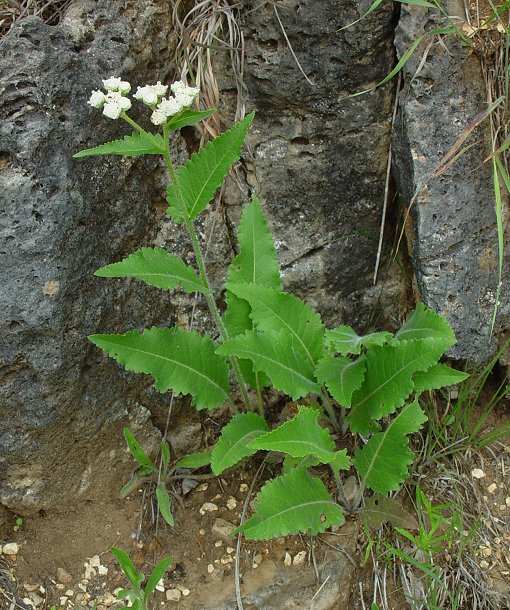Parthenium hispidum Raf.
Wild Quinine

Native
CC = 9
CW = 5
MOC = 41
© DETenaglia
Parthenium hispidum Raf.Wild Quinine | |
 |
Native CC = 9 CW = 5 MOC = 41 |
© DETenaglia |
|
Family - Asteraceae/Heliantheae Habit - Perennial forb, usually colonial, with scattered stems from a branched, long-creeping rhizome.
Stems - Erect, to 1 m, usually unbranched below the inflorescence, moderately to more commonly densely pubescent with short, stiff, spreading hairs toward the base, the hairs becoming shorter and more appressed toward the stem tip.
Leaves - Alternate, petiolate to sessile, scabrous. Basal and lower stem leaves long-petiolate, the blades 12-30 cm long, elliptic to ovate, long-tapered to the petiole at the base, angled or tapered to a bluntly or sharply pointed tip, unlobed or those of the largest leaves rarely with a few short lobes toward the base, the margins otherwise coarsely toothed or scalloped, with relatively dense, spreading hairs along the undersurface midvein, otherwise moderately to densely pubescent with shorter, spreading hairs. Median and upper stem leaves short-petiolate to sessile, the blade mostly 2-15 cm long, lanceolate to ovate, angled or tapered to the petiole or, in sessile leaves, often rounded to shallowly cordate and sometimes somewhat clasping the stem, the margins and surfaces more or less like those of the lower leaves.
Inflorescence - Flat-topped, dense corymbiform arrangement of flower heads terminating stems. Peduncles densely pubescent with multicellular hairs. Small bracts present at divisions of inflorescence and often subtending involucre.
Heads - Involucres 4-6 mm long, 6-10 mm in diameter, the bracts of the outer series slightly shorter than the others, lanceolate to broadly ovate, those of the inner series broadly ovate to nearly circular. Phyllaries densely covered with multicellular pubescence. Receptacle convex to short-conical, with chaffy bracts subtending the ray and disc florets, these densely hairy on the outer surface toward the tip, those of the disc florets concave and wrapped around the florets.
Fruits - Achenes 3-5 mm long. Flowering - May - October. Habitat - Glades, upland prairies, savannas, forest openings, bluffs, railroads, roadsides. Origin - Native to the U.S. Lookalikes - P. integrifolium. Other info. - This species has long been treated as a subspecies of P. integrifolium, though many botanists now accept it as a discrete species. In Missouri the two entities are usually easily differentiated. P. hispidum differs from P. integrifolium in having more spreading, bristly hairs, particularly along the stem and leaf undersides, and usually exhibits a more colonial disposition due to having long-creeping rhizomes. The flowering stems are also shorter. P. hispidum is somewhat less common than P. integrifolium, and in Missouri is mostly restricted to the lower 2/3 of the state. Photographs taken in the Ozark Scenic Riverways, Shannon County, MO., 5-28-03, and in Providence Prairie, Lawrence County, MO., 6-18-05 (DETenaglia); also at Don Robinson State Park, Jefferson County, MO, 6-20-2023 (SRTurner). |